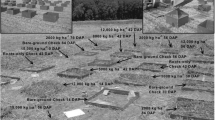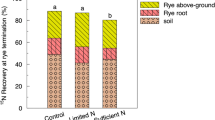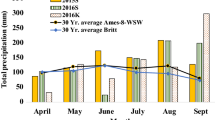Abstract
Cereal rye (Secale cereale) is widely adopted as a cover crop in the Midwest, USA, because of its nitrogen (N) scavenging ability. However, there is a dearth of knowledge regarding cereal rye N fate and utilization by the subsequent corn or soybean crop. Thus, the objectives of this study were to (i) Investigate the uptake of newly applied spring N fertilizer by cereal rye by measuring the recovery of spring-applied N by cereal rye before chemical termination, (ii) Quantify cereal rye N uptake at multiple growth stages to ascertain the timing and amount of cereal rye N utilized by the subsequent corn (Zea mays L.) or soybean (Glycine max L.) crop, and (iii) Examine the fate and partitioning of cereal rye N at harvest, in plant tissue, and at soil depths. First, we found that cereal rye N uptake accounted for between 9 and 37% of spring N. Second, we observed that corn and soybean utilized an average of 9.3% of cereal rye residue N and did not contribute meaningfully to corn and soybean N. Third, our data showed that an average of 31% of cereal rye N was partitioned into the soil profile (0–0.3 m) at harvest. Finally, across all site-years, an average of nearly four times more cereal rye N was recovered in the soil then was utilized by the subsequent corn and soybean. Thus, data from this study suggests that the fate of most cereal rye N is in the soil; and is only utilized marginally by the subsequent corn and soybean crop.



Similar content being viewed by others
Data availability
Not applicable.
Code availability
Not applicable.
References
Basche A, Archontoulis S, Kaspar T, Jaynes D, Parkin T, Miguez F (2016) Simulating long-term impacts of cover crops and climate change on crop production and environmental outcomes in the Midwestern United States. Agr Ecosyst Environ 218:95–106
Blake GR, Hartge KH (1986) Bulk Density. In: Klute A (ed) Methods of soil analysis: part 1 physical and mineralogical methods. ASA, Madison, WI, USA, pp 363–375
Blesh J, Drinkwater LE (2014) Retention of 15N-Labeled Fertilizer in an Illinois Prairie Soil with Winter Rye. Soil Sci Soc Am J 78(2):496–508
Bender RR, Haegele JW, Ruffo ML, Below FE (2013) Modern corn hybrids’ nutrient uptake patterns. Better Crops 97(1):7–10
Brandi-Dohrn FM, Hess M, Selker JS, Dick RP, Kauffman SM, Hemphill DD Jr (1997) Nitrate leaching under a cereal rye cover crop. J Environ Qual 26:181–188
Canisares LP, Grove J, Miguez F, Poffenbarger H (2021) Long-term no-till increases soil nitrogen mineralization but does not affect optimal corn nitrogen fertilization practices relative to inversion tillage. Soil Tillage Res 213:105080
Chahal I, Vyn RJ, Mayers D, Van Eerd LL (2020) Cumulative impact of cover crops on soil carbon sequestration and profitability in a temperate humid climate. Sci Rep 10(1):1–11
David M., McIsaac G, Czapar G, Schnitkey G, and Mitchell C (2013) science assessment to support an Illinois nutrient loss reduction strategy. http://biogeochemistry.nres.illinois.edu/Biogeochem_lab/Science_documents/Illinois_Science_Assessment_Report_May_6.pdf. (Accessed 8 May 2019)
Drury CF, Tan CS, Welacky TW, Reynolds WD, Zhang TQ, Oloya TO, Gaynor JD (2014) Reducing nitrate loss in tile drainage water with cover crops and water-table management systems. J Environ Qual 43(2):587–598
Gaspar AP, Laboski CA, Naeve SL, Conley SP (2017) Dry matter and nitrogen uptake, partitioning, and removal across a wide range of soybean seed yield levels. Crop Sci 57(4):2170–2182
Greub KL, Roberts TL (2020) 15N fertilizer recovery and partitioning by cover crops under greenhouse conditions. Agron J 112(6):5300–5311
Hadas A, Doane TA, Kramer AW, Van Kessel C, Horwath WR (2002) Modelling the turnover of 15N-labelled fertilizer and cover crop in soil and its recovery by maize. Eur J Soil Sci 53(4):541–552
Hart PBS, Rayner JH, Jenkinson DS (1986) Influence of pool substitution on the interpretation of fertilizer experiments with 15N. J Soil Sci 37(3):389–403
Hauck RD, Bremner JM (1976) Use of tracers for soil and fertilizer nitrogen research. Adv Agron 28:219–266
Jahanzad E, Barker A, Hashemi M, Eaton T, Sadeghpour A, Weis S (2016) Nitrogen release dynamics and decomposition of buried and surface cover crop residues. Agron J 108(4):1735–1741
Jenkinson DS, Fox RH, Rayner JH (1985) Interactions between fertilizer nitrogen and soil nitrogen-the so-called ‘priming’ effect. J Soil Sci 36(3):425–444
Kaspar TC, Jaynes DB, Parkin TB, Moorman TB (2007) Rye cover crop and gamagrass strip effects on NO3 concentration and load in tile drainage. J Environ Qual 36(5):1503–1511
Kaspar TC, Jaynes DB, Parkin TB, Moorman TB, Singer JW (2012) Effectiveness of oat and rye cover crops in reducing nitrate losses in drainage water. Agric Water Manag 110:25–33
Lacey C, and Armstrong S (2014) In field measurements of nitrogen mineralization following fall applications of N and the termination of winter cover crops. Air, Soil Water Res 7: ASWR-S13861
Lacey C, Armstrong S (2015) The efficacy of winter cover crops to stabilize soil inorganic nitrogen after fall-applied anhydrous ammonia. J Environ Qual 44(2):442–448
Lacey C, Nevins C, Camberato J, Kladivko E, Sadeghpour A, Armstrong S (2020) Carbon and nitrogen release from cover crop residues and implications for cropping systems management. J Soil Water Conserv 75(4):505–514
Liu A, Ma B, Bomke A (2005) Effects of cover crops on soil aggregate stability, total organic carbon, and polysaccharides. Soil Sci Soc Am J 69:2041–2048
Muchanga RA, Uchida Y, Hirata T, Hatano R, Araki H (2020) Dynamics of N derived from 15N-labeled rye in soil–tomato system as influenced by cover crop residue management. Hortic J 89(4):394–402
Nevins C, Nakatsu C, Armstrong S (2018) Characterization of microbial community response to cover crop residue decomposition. Soil Biol Biochem 127:39–49
Nevins CJ, Lacey C, Armstrong S (2020) The synchrony of cover crop decomposition, enzyme activity, and nitrogen availability in a corn agroecosystem in the Midwest United States. Soil Tillage Res 197:104518
Nevins CJ, Lacey C, Armstrong S (2021) Cover crop enzyme activities and resultant soil ammonium concentrations under different tillage systems. Eur J Agron 126:126277
Ovalle C, González MI, Hirzel J, Pino I, Del Pozo A, and Urquiaga S (2005) Contribution and transfer of nitrogen from cover crops to raspberry plant using isotopic techniques with 15N. In: IX International Rubus and Ribes Symposium 777: 465–472
Poeplau C, Don A (2015) Carbon sequestration in agricultural soils via cultivation of cover crops-a meta-analysis. Agric Ecosyst Environ 200:33–41
Ranells N, Wagger M (1992) Nitrogen release from crimson clover in relation to plant growth stage and composition. Agron J 84(3):424–430
Ranells N, Wagger M (1996) Nitrogen release from grass and legume cover crop monocultures and bicultures. Agron J 88(5):777–882
Ranells NN, Wagger MG (1997) Nitrogen-15 recovery and release by rye and crimson clover cover crops. Soil Sci Soc Am J 61(3):943–948
Roth RT, Ruffatti MD, O’Rourke PD, Armstrong SD (2018) A cost analysis approach to valuing cover crop environmental and nitrogen cycling benefits: A central Illinois on farm case study. Agric Syst 159:69–77
Ruffatti M, Roth R, Lacey C, Armstrong S (2019) Impacts of nitrogen application timing and cover crop inclusion on subsurface drainage water quality. Agric Water Manag 211:81–88
Ruffo ML, Bollero GA (2003) Modeling rye and hairy vetch residue decomposition as a function of degree-days and decomposition-days. Agron J 95(4):900–907
Sadeghpour A, Adeyemi O, Hunter D, Luo Y, Armstrong S (2021) Precision planting impacts on winter cereal rye growth, nutrient uptake, spring soil temperature and adoption cost. Renew Agric Food Syst 36:1–6
Salvagiotti F, Cassman K, Specht K, Walters D, Weiss A, Dobermann A (2008) Nitrogen uptake, fixation and response to fertilizer N in soybeans: a review. Field Crop Res 108(1):1–13
SARE-CTIC. (2017) 2016–2017 Cover Crop Survey Report. North central sustainable agriculture research & education-conservation technology information center. http://www.sare.org/Learning-Center/From-the-Field/North-Central-SARE-From-the-Field/2016-17-Cover-Crops-Survey-Analysis. (Accessed 8th May 2018)
Schipanski ME, Barbercheck M, Douglas MR, Finney DM, Haider K, Kaye JP, White C (2014) A framework for evaluating ecosystem services provided by cover crops in agroecosystems. Agric Syst 125:12–22
Sievers T, Cook R (2018) Aboveground and root decomposition of cereal rye and hairy vetch cover crops. Soil Sci Soc Am J 82(1):147–155
Singh G, Dhakal M, Yang L, Kaur G, Williard KW, Schoonover JE, Sadeghpour A (2020) Decomposition and nitrogen release of cover crops in reduced-and no-tillage systems. Agron J 112(5):3605–3618
Wells M, Reberg-Horton S, Smith A, Grossman J (2013) The reduction of plant-available nitrogen by cover crop mulches and subsequent effects on soybean performance and weed interference. Agron J 105(2):539–545
Westgate L, Singer J, Kohler K (2005) Method and timing of rye control affects soybean development and resource utilization. Agron J 97(3):806–816
Acknowledgements
We would like to thank both Purdue Agronomy Center for Research and Education and the Illinois State University farm staff for logistical support and technical expertise. We would also like to thank Mike Ruffatti, Soil Scientist, and Richard Roth, a graduate research assistant at Purdue University, for assistance in sample collection. Additionally, we would like to acknowledge the Indiana Corn Marketing Council, the Indiana Soybean Association, and the Illinois Nutrient Research and Education Council who provided partial funding for this research.
Funding
This research was partially funded by the Illinois Nutrient Research and Education Council, Indiana Corn Marketing Council, Indiana Soybean Association.
Author information
Authors and Affiliations
Corresponding author
Ethics declarations
Conflicts of interest
Authors declare that they have no conflict of interest.
Additional information
Publisher's Note
Springer Nature remains neutral with regard to jurisdictional claims in published maps and institutional affiliations.
Appendix
Appendix
See Tables
3,
4 and
5.
Rights and permissions
Springer Nature or its licensor holds exclusive rights to this article under a publishing agreement with the author(s) or other rightsholder(s); author self-archiving of the accepted manuscript version of this article is solely governed by the terms of such publishing agreement and applicable law.
About this article
Cite this article
Lacey, C., Camberato, J. & Armstrong, S. Field based 15 N study: an investigation of cereal rye N fate and utilization by the subsequent corn and soybean. Nutr Cycl Agroecosyst 125, 205–217 (2023). https://doi.org/10.1007/s10705-022-10226-0
Received:
Accepted:
Published:
Issue Date:
DOI: https://doi.org/10.1007/s10705-022-10226-0




